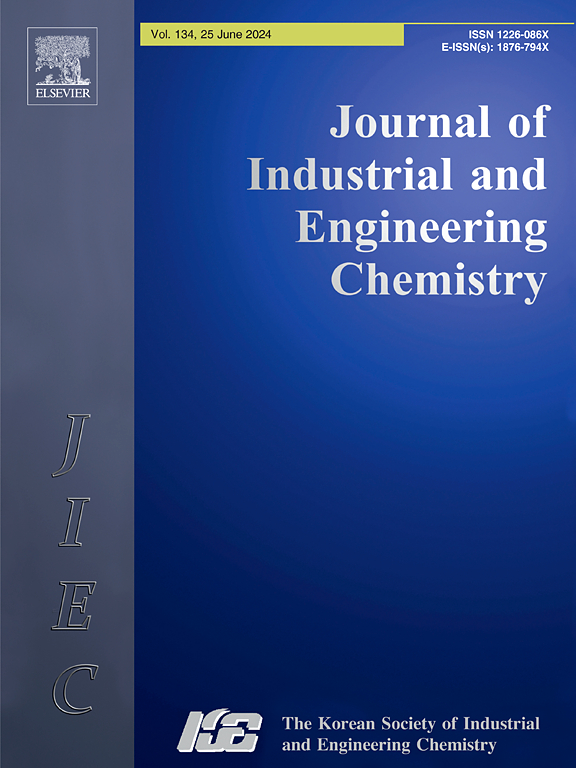Using natural antioxidant Rhubarb extracts in PVA/chitosan bio-adsorbent films for efficient removal of cationic and anionic dyes from polluted water
IF 5.9
3区 工程技术
Q1 CHEMISTRY, MULTIDISCIPLINARY
Journal of Industrial and Engineering Chemistry
Pub Date : 2025-01-25
DOI:10.1016/j.jiec.2024.09.049
引用次数: 0
Abstract
In this research, sustainable membrane films were developed for removal of cationic and anionic dyes from wastewater based on polyvinyl alcohol/chitosan (PVA/CS) incorporated with natural antioxidant Rhubarb dye (Rh) extracts. Rh dye was extracted from Rhubarb roots by a green method. Three different quantities of Rh dye extracts (i.e., 2.5, 5, and 10 %) were used to fabricate crosslinked PVA/CS films by solvent-casting approach. The fabricated films subjected to different techniques such as X-ray diffraction (XRD), scanning electron microscopy combined with energy dispersive X-ray spectroscopy (SEM-EDX), dynamic mechanical analysis (DMA), as well as antioxidant activity. In all cases, the incorporation of Rh dye extracts inside the composite improved the crystallinity, biocompatibility, stress–strain properties, besides the DPPH scavenging activity reached 42.50 % for PVA/CS-10 % Rh membrane compared to PVA/CS blank (i.e., ∼ 2.10 %). Dyes adsorption including different cationic and anionic dyes implemented for all selected membranes. The data revealed that the membrane containing 10 % Rh dye was the optimum for removal of malachite green oxide (MG, 93 %) as cationic dye and methyl orange (MO, 95.70 %) as anionic dye. Moreover, the kinetics of the removal process exhibited that this process followed the Langmuir, Freundlich, Temkin, Dubinin-Radushkevich models, and the pseudo-1st order kinetic model, with an R2 of 0.998 and 0.943 for MG and MG, respectively. Whereas, the adsorption process corresponded to the Freundlich isotherm model, with coefficients R2 was of 0.989 and 0.988 for MO and MG, respectively. Other parameters including dye concentration, contacting time, pH media, and kinetic studies were also applied on PVA/CS-10 % Rh membrane.

求助全文
约1分钟内获得全文
求助全文
来源期刊
CiteScore
10.40
自引率
6.60%
发文量
639
审稿时长
29 days
期刊介绍:
Journal of Industrial and Engineering Chemistry is published monthly in English by the Korean Society of Industrial and Engineering Chemistry. JIEC brings together multidisciplinary interests in one journal and is to disseminate information on all aspects of research and development in industrial and engineering chemistry. Contributions in the form of research articles, short communications, notes and reviews are considered for publication. The editors welcome original contributions that have not been and are not to be published elsewhere. Instruction to authors and a manuscript submissions form are printed at the end of each issue. Bulk reprints of individual articles can be ordered. This publication is partially supported by Korea Research Foundation and the Korean Federation of Science and Technology Societies.

 求助内容:
求助内容: 应助结果提醒方式:
应助结果提醒方式:


